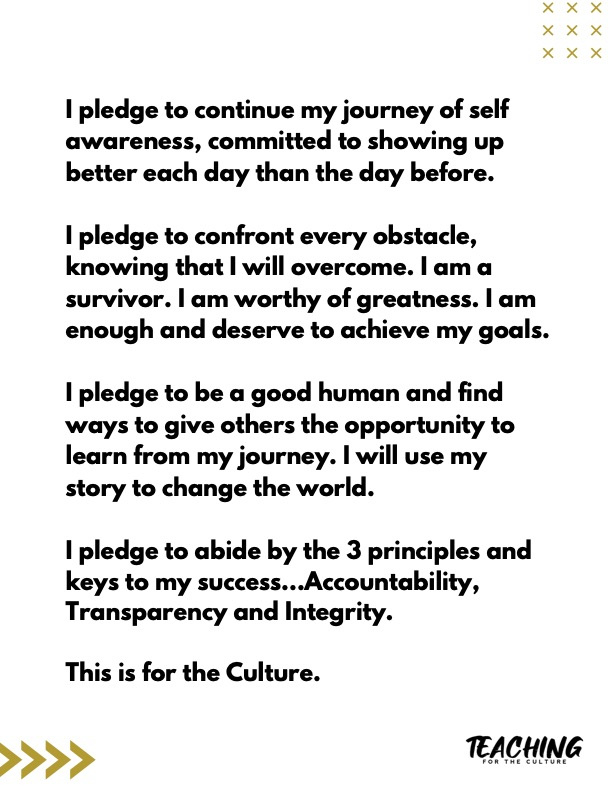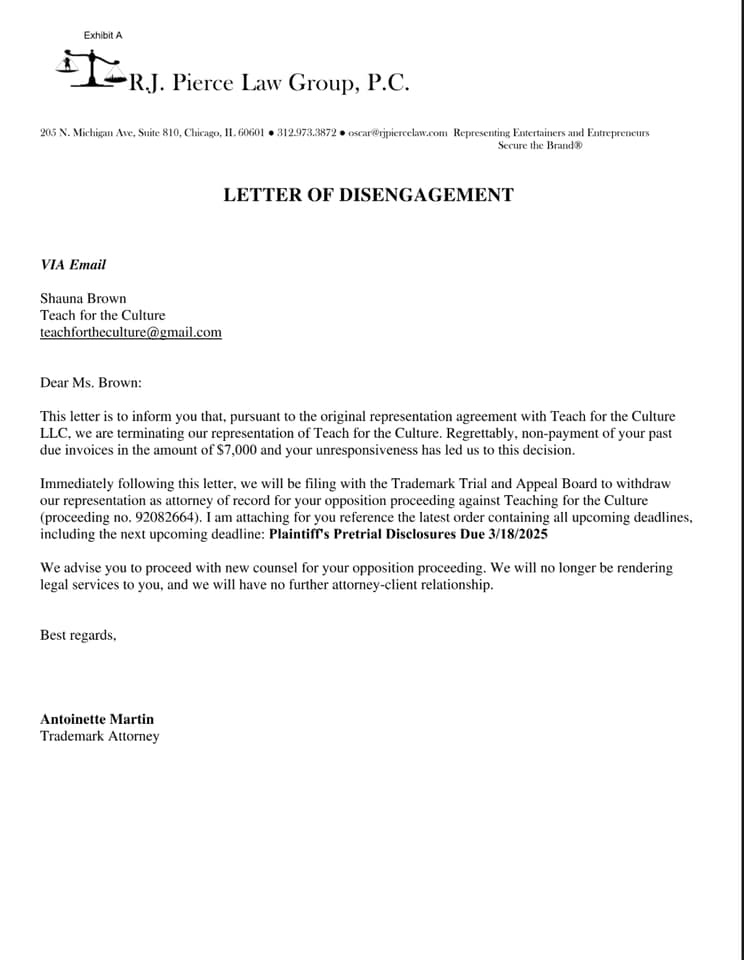Some stories make headlines. Others belong in law school textbooks. The ongoing trademark battle between Teaching for the Culture and Teach for the Culture isn’t just a legal dispute—it’s a masterclass in brand protection, accountability, and the dark side of vanity metrics on social media.
In business, a brand is more than just a name. It’s identity. It’s reputation. It’s trust. Trademarks play a critical role in protecting that identity, legally safeguarding names, logos, and slogans. When two entities operate under similar names, it doesn’t just blur the lines—it breeds confusion, misrepresentation, and deception, ultimately diluting a brand’s value. That’s why trademark laws exist: to prevent these conflicts and uphold brand integrity.
But what happens when someone decides to test those boundaries?
This is the story of a business owner who attempted to rewrite history, manipulate receipts, and trademark her way into another brand’s legacy. It’s a story about truth, fighting back, and, most importantly, holding people accountable when they refuse to do what’s right.
The Birth of Teaching for the Culture
As a business technology educator in a Title I school, my mission extended beyond teaching—I was preparing students for the digital future, focusing on digital literacy and safety. From Microsoft certifications to coding and digital design, I empowered children to use technology as a pathway to opportunity.
My impact reached beyond the classroom. Through the hashtag #StoryTimein410, I documented educational realities—the triumphs, challenges, and systemic failures. This advocacy came at a personal cost, taking a toll on my mental health and professional standing.
In 2019, during Teacher Appreciation Week, I published an op-ed that went viral, sparking national conversations about education. This catalyst moment showed me that my impact needed to extend further.
I partnered with educational activists, consultants, attorneys, and community leaders to transform Teaching for the Culture from a platform into a movement—one built on the three pillars of Accountability, Transparency, and Integrity.

Building a Brand with Purpose
Teaching for the Culture was never just about a name. We took concrete action:
- Hosted panel discussions bringing together educators, parents, and community leaders
- Provided advocacy for those mistreated or silenced by educational systems
- Delivered thousands of resources to local schools
- Held school districts accountable by exposing corruption and failed leadership
- Launched initiatives against discriminatory disciplinary actions partnering with the NAACP Legal Defense Fund
We created a safe space dedicated to Transform, Educate, Advocate, Coach, and Heal—built organically without purchased followers or artificial engagement.
Through this genuine work, Teaching for the Culture became a trusted, recognizable brand in education advocacy. So imagine our shock when we discovered that someone had created “Teach for the Culture, LLC,” using similar branding colors and causing widespread confusion.
Supporters began tagging the wrong page, asking if we had rebranded, or wondering about affiliations. This wasn’t mere coincidence—it was brand confusion in real-time.
The -ING That Started A War
Enter Teach for the Culture, LLC, a Connecticut-based business run by Shauna Brown. The only difference? The -ING.
At first, we thought this was an honest mistake. Maybe Shauna Brown didn’t realize that a well-established, community-rooted organization was already operating under a nearly identical name. So, in good faith, we sent a cease and desist letter.
We laid out the issue clearly:
- Our name, Teaching for the Culture, was already federally trademarked.
- Our work, brand, and public recognition predated her business registration.
- There was clear confusion happening among our supporters and community.
Instead of acknowledging the issue, she hired a trademark attorney and filed three trademark applications of her own. If she truly believed she was the rightful owner of the name, the law required one thing: receipts. If she genuinely believed she held priority rights, this would be a reasonable legal approach—submit the claim, provide evidence, and let the law determine precedence.
The Trademark Office Saw Right Through It
The U.S. Patent and Trademark Office (USPTO) doesn’t care about social media clout—it cares about evidence. When they reviewed her applications, they saw exactly what we saw:
- Likelihood of confusion—Teaching for the Culture was already a federally registered trademark.
- The only difference was the verb tense of the word “teach.”
- She had no legitimate claim to priority.
All three applications? Denied.
Shauna Brown failed to provide sufficient documentation proving that she had used Teach for the Culture in commerce before Teaching for the Culture was established. She had no solid proof of priority, no verifiable business operations under that name before us, and no real documentation that could challenge our trademark.
The USPTO examiner stated explicitly: “The only difference between the marks is that in the applicant’s mark, the term TEACH is a verb that is in the present tense, and in the registrant’s mark, the term TEACH is in its present progressive tense, namely, TEACHING.”
If she had the receipts to prove she was the rightful first user, this would have been a different conversation. But here’s the thing—she didn’t. And that’s when things got messy.
Instead of fixing the problem when the USPTO called it out, she kept pushing.
What happened next? A full-blown trademark war.
The Lawsuit That Shouldn’t Exist
Not only did Shauna Brown attempt to claim rights over Teach for the Culture, but she also went a step further—filing a petition to cancel our federally registered trademark. This legal move was a direct challenge to the validity of our trademark, despite the overwhelming evidence that Teaching for the Culture had priority and a clear presence long before her entity even existed.
Her petition argued that our trademark should be invalidated, but just like her trademark applications, this claim lacked the necessary receipts. When she was required to provide documented proof that she had prior rights to the name, she failed—time and time again. During discovery, she couldn’t present substantive evidence that Teach for the Culture was in use before Teaching for the Culture was legally established.
When asked for supporting documents in discovery? Her response: “No responsive documents at this time. Investigation ongoing.”
Here’s the link to view the receipt from the USPTO: https://tsdr.uspto.gov/caseviewer/pdf?caseId=90486725&docIndex=14&searchprefix=sn#docIndex=14
Her Own Lawyer Said, “I’m Out”

On February 27, 2025, Shauna Brown’s attorney officially withdrew from the case—not due to resolution, but because she had stopped paying legal fees and become unresponsive.
This is particularly telling given that she initiated this legal battle, filed multiple trademark applications despite clear conflicts, petitioned to cancel our registered trademark, and prolonged the dispute for nearly three years.
I’ve invested over $10,000 in legal fees defending Teaching for the Culture, responding to every request and fulfilling all legal obligations. Meanwhile, the person who forced this financial burden couldn’t maintain her own legal representation or provide evidence supporting her claims.
The Clock Is Ticking
Because she is now unrepresented, the petition to cancel our trademark has been suspended for 30 days. Shauna Brown has until April 2, 2025, to secure new counsel or represent herself before the Trademark Trial and Appeal Board.
If this deadline passes without action, the case could be decided against her by default—rendering all the time, money, and legal maneuvers moot due to her failure to follow through on an action she initiated.
I’ve done my best to protect my peace, but I won’t sugarcoat it—this battle has harmed me in ways that go beyond money. As a result, I’m sharing this story to help every entrepreneur, creative, and business owner about the importance of protecting your intellectual property and keeping your receipts in order.
Why This Matters for Every Entrepreneur
This case offers crucial lessons for all creators and business owners:
Lesson #1 – Proactive Protection: Trademark your name, copyright your content, and document everything from the beginning.
Lesson #2 – Evidence Is Essential: The internet makes it easy to fabricate a backstory and buying followers on social media is easy, but in court you need receipts.
Lesson #3 – Integrity in Business: There’s enough room for everyone to succeed without appropriating someone else’s foundation.
This isn’t just about a name—it’s about truth, integrity, and standing firm for what you’ve built.
Because while stories can be rewritten, legal documents speak for themselves. People may lie, but receipts don’t.
And if there’s one thing you take from this story—let it be this: Protect your vision. Defend your work. And don’t let the noise and illusions of social media distract you from your purpose.
Bianca Goolsby, MBA is a digital strategist and activist who partners with mission-driven organizations to increase their impact through innovative and effective online communications. She also empowers and equips families to curate safe social spaces for themselves and their children.

